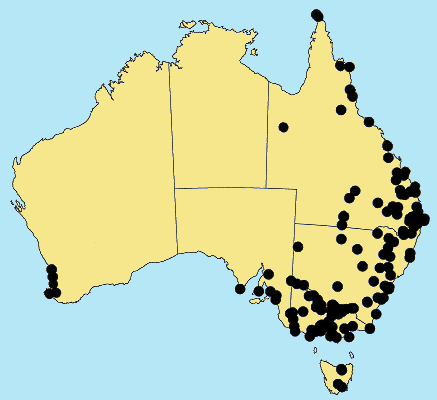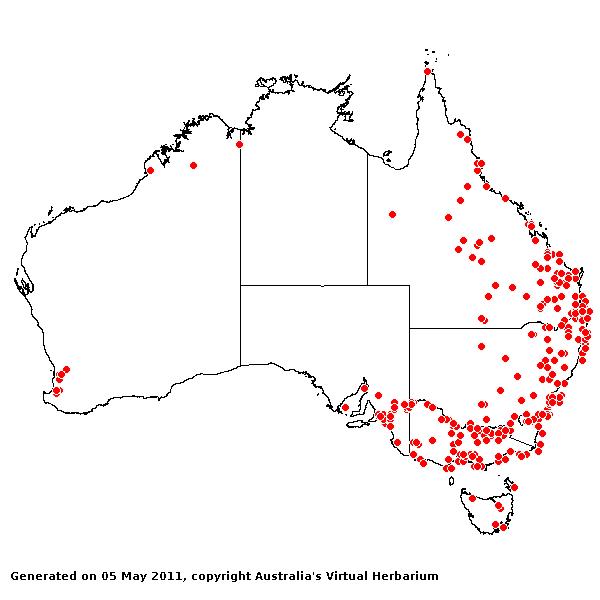Paspalum distichum* L. Syst. Nat. ed.10,
2: 855 (1759).
Classification. (GPWG 2001) : Subfamily
Panicoideae. Paniceae.
Type of Basionym or
Protologue Information: LT: Browne s.n., Jamaica (LINN-75.9, second
fertile culm from the left). LT designated by Guedes, Taxon 25: 513
(1976), and earlier discussed by Jovet & Guedes, Taxon 21: 546
(1972); formally ruled on by Nom. Comm., Taxon 32: 281 (1983).
Recent synonyms:
P. paspalodes.
Key references
(books and floras): [1878] G.Bentham, Flora Australiensis 7 (460),
[1952] C.A.Gardner, Flora of Western Australia 1 Gramineae (241),
[2002] D.Sharp & B.K.Simon, AusGrass, Grasses of Australia, [2002]
J.Wheeler, N.Marchant & M.Lewington, Flora of the South West (425), [2006]
J.Jessop, G.R.M.Dashorst, F.M.James, Grasses of South Australia (469),
[2008] S.W.L.Jacobs, R.D.B.Walley & D.J.B.Wheeler, Grasses of New South
Wales (327).
Illustrations:
[2006] J.Jessop, G.R.M.Dashorst, F.M.James, Grasses of South Australia (469, Fig. 402), [2008] S.W.L.Jacobs,
R.D.B.Whalley & D.J.B.Wheeler, Grasses of New South Wales, 4th edn
(327).
Habit. Perennial.
Rhizomes absent or present, short. Stolons present. Culms erect or decumbent,
8–60 cm tall, 5–15 -noded. Mid-culm nodes glabrous. Lateral branches simple.
Leaf-sheaths glabrous on surface. Leaf-sheath auricles absent. Ligule an
eciliate membrane, 0.7–1.6 mm long. Leaf-blades flat or convolute, 2–22 cm
long, 2–7 mm wide. Leaf-blade surface smooth or scabrous, glabrous.
Inflorescence.
Inflorescence digitate, a panicle of racemes. Racemes 2(–3), spreading, 1.5–8
cm long, 1.1–1.8 mm wide, bearing 15–50 fertile spikelets on each. Central
inflorescence axis 0–1.5 cm long.
Spikelets.
Spikelets sessile. Fertile spikelets 2-flowered, the lower floret barren
(rarely male), the upper fertile, comprising 1 basal sterile florets,
comprising 1 fertile floret(s), without rachilla extension, ovate, dorsally
compressed, 2.6–4 mm long.
Glumes. Glumes
thinner than fertile lemma. Lower glume when present ovate, hyaline, 0 -nerved.
Upper glume elliptic, 2.6–3.6 mm long, membranous or chartaceous or coriaceous,
without keels, 3–6 -nerved. Upper glume surface indumented. Florets.
Basal sterile florets 1, barren, without significant palea. Lemma of lower
sterile floret 100 % of length of spikelet, coriaceous, 3–5 -nerved.
Fertile lemma 2.4–3.6
mm long, without keel.
Continental
Distribution: Europe, Africa, Temperate Asia, Tropical Asia, Australasia,
Pacific, North America, and South America.
Australian
Distribution: Western Australia, South Australia, Queensland, New South
Wales, Victoria, Tasmania, Lord Howe.
Western Australia:
Drummond, Dale. South Australia: Murray, Southern Lofty. Queensland:
Burke, Burnett, Cook, Darling Downs, Maranoa, Moreton, North Kennedy, Port
Curtis, South Kennedy, Warrego, Wide Bay. New South Wales: North Coast,
Central Coast, South Coast, Northern Tablelands, Central Tablelands, Southern
Tablelands, North-Western Slopes, Central-Western Slopes, South-Western Slopes,
North-Western Plains, South-Western Plains, North Far Western Plains. Victoria:
East Gippsland, Eastern Highlands, Gippsland Highlands, Gippsland Plain,
Grampians, Lowan Mallee, Midlands, Murray Mallee, Otway Plain, Otway Range,
Riverina, Volcanic Plain, Wannon, Wimmera. Tasmania: Midlands, East
Coast.
Notes. Similar
to P. vaginatum but differs in spikelet shape, pubescence of the upper
glume and texture of the lower lemma and upper glume. Prefers moist ditches or
coastal areas and associated with fresh water. Valuable pasture grass on
alluvial flats and useful as a fodder for cattle, and as a soil binder on
stream banks.
Introduced. In tropical
heaths, tropical and subtropical rain forests, tropical and subtropical wet
sclerophyll forests, dry sclerophyll forests, tropical and subtropical
sub-humid woodlands, temperate sub-humid woodlands, semi-arid shrub woodlands,
and acacia shrublands. Prefers moist ditches or coastal areas and associated
with fresh or salt water. Flowers sporadically throughout the year.






